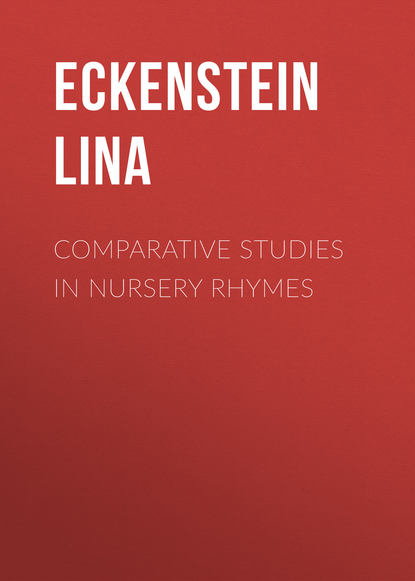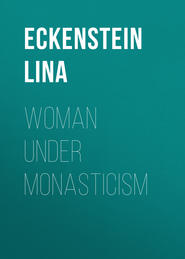По всем вопросам обращайтесь на: info@litportal.ru
(©) 2003-2024.
✖
Comparative Studies in Nursery Rhymes
Настройки чтения
Размер шрифта
Высота строк
Поля
Buy this of me: – What is it?
Three monkeys tied to a clog,
Two pudding ends will choke a dog, etc.
The answer to the last question stood as follows: —
Twelve huntsmen with horns and hounds,
Hunting over other men's grounds;
Eleven ships sailing o'er the main,
Some bound for France and some for Spain,
I wish them all safe home again;
Ten comets in the sky,
Some low and some high;
Nine peacocks in the air,
I wonder how they all came there,
I do not know and I don't care;
Eight joiners in joiner's hall
Working with their tools and all.
Seven lobsters in a dish,
As fresh as any heart could wish;
Six beetles against the wall [or six spiders in the wall],
Close by an old woman's apple stall;
Five puppies by our bitch Ball
Who daily for their breakfast call;
Four horses stuck in a bog;
Three monkeys tied to a clog;
Two pudding ends would choke a dog;
With a gaping wide-mouthed waddling frog.
Many rhymes that originated in these nonsense verses have found their way into nursery collections. Halliwell printed the following lines as a separate nursery rhyme: —
Eight ships on the main,
I wish them all safe back again;
Seven eagles in the air,
I wonder how they all came there;
I don't know, nor I don't care.
Six spiders on the wall,
Close to an old woman's apple stall;
Five puppies in Highgate hall,
Who daily for their breakfast call;
Four mares stuck in a bog,
Three monkeys tied to a log,
Two pudding ends will choke a dog,
With a gaping wide mouthed waddling frog.
(1842, p.246.)
Halliwell also printed some utterly debased rhymes, in which, however, numbers are still combined with the objects that are named. Among these rhymes is the following: —
One old Oxford ox opening oysters;
Two teetotums totally tired of trying to trot to Tadbury;
Three tall tigers tippling tenpenny tea;
Four fat friars fanning fainting flies;
And so on to
Twelve typographical typographers typically translating types.
(1846, p. 111.)
Other rhymes of this kind depend for their consistency on alliteration only, such as: —
Robert Rowley rolled a round roll round,
A round roll Robert Rowley rolled round;
Where rolled the round roll Robert Rowley rolled round.
(1842, p. 128.)
Robert Rowley is perhaps a name for thunder, since a rhyme recited in the North of England as a charm against thunder is: —
Rowley, Rowley, Rattley-bags;
Take the lasses and leave the lads.
(1876, p. 15.)
Another rhyme of this class begins: —
Peter Piper picked a peck of pickled pepper, etc.
(1842, p. 129.)
And the time-honoured rhyme, "When a twister a twisting," etc., has been traced back by Halliwell to a collection of 1674. This has a French parallel: —
Si un cordonnier accordant veut accorder sa corde, etc.
I do not know if the English or the French version is the older one.
CHAPTER XIII
CHANTS OF THE CREED
THE game of Twelve Days, especially in one French version, shows that instruction was conveyed by the cumulative mode of recitation. There are many pieces enlarging on matters of belief – Hebrew, Christian, Druidical, and heathen – which in the same way associate numbers with objects. The comparison of these pieces suggests that they are all derived from one original source. They may fitly be termed Chants of the Creed.
One of these cumulative chants is included in the Hebrew service for the night of the Passover, which is called Echod mi jodea, "He who knows."[55 - Tylor, E. B., Primitive Culture, I, 87, citing Mendes, Service for the First Nights of the Passover, 1862.] It is recited to a monotonous tune after the return of the family from celebration, either by the master of the house or by the assembled company. The dialogue form, I am told, is no longer observed. The piece begins: —
Who knoweth One? – I, saith Israel, know One.
One is God, who is over heaven and earth.
Who knoweth Two? – I, saith Israel, know Two.
Two tables of the covenant; but One is our God who is over the heavens and the earth…
And so forth to the last verse, which is as follows: —
Who knoweth thirteen? – I, saith Israel, know thirteen: Thirteen divine attributes – twelve tribes – eleven stars – ten commandments – nine months preceding childbirth – eight days preceding circumcision – seven days of the week – six books of the Mishnah – five books of the Law – four matrons – three patriarchs – two tables of the covenant – but One is our God, who is over the heavens and the earth.
The same chant adapted to matters of Christian belief, but carried only from one to twelve, is current also in Latin, Italian, Spanish, French, German, and Danish. Among ourselves it is set as a song. But the objects which are associated with the numbers are not uniformly the same, and this renders it probable that the chants were composed independently of one another. This view is supported by the fact that some of the items that are named in the Christian chants are not Christian, and are, in fact, identical with the items named in the entirely heathen chants.
Three monkeys tied to a clog,
Two pudding ends will choke a dog, etc.
The answer to the last question stood as follows: —
Twelve huntsmen with horns and hounds,
Hunting over other men's grounds;
Eleven ships sailing o'er the main,
Some bound for France and some for Spain,
I wish them all safe home again;
Ten comets in the sky,
Some low and some high;
Nine peacocks in the air,
I wonder how they all came there,
I do not know and I don't care;
Eight joiners in joiner's hall
Working with their tools and all.
Seven lobsters in a dish,
As fresh as any heart could wish;
Six beetles against the wall [or six spiders in the wall],
Close by an old woman's apple stall;
Five puppies by our bitch Ball
Who daily for their breakfast call;
Four horses stuck in a bog;
Three monkeys tied to a clog;
Two pudding ends would choke a dog;
With a gaping wide-mouthed waddling frog.
Many rhymes that originated in these nonsense verses have found their way into nursery collections. Halliwell printed the following lines as a separate nursery rhyme: —
Eight ships on the main,
I wish them all safe back again;
Seven eagles in the air,
I wonder how they all came there;
I don't know, nor I don't care.
Six spiders on the wall,
Close to an old woman's apple stall;
Five puppies in Highgate hall,
Who daily for their breakfast call;
Four mares stuck in a bog,
Three monkeys tied to a log,
Two pudding ends will choke a dog,
With a gaping wide mouthed waddling frog.
(1842, p.246.)
Halliwell also printed some utterly debased rhymes, in which, however, numbers are still combined with the objects that are named. Among these rhymes is the following: —
One old Oxford ox opening oysters;
Two teetotums totally tired of trying to trot to Tadbury;
Three tall tigers tippling tenpenny tea;
Four fat friars fanning fainting flies;
And so on to
Twelve typographical typographers typically translating types.
(1846, p. 111.)
Other rhymes of this kind depend for their consistency on alliteration only, such as: —
Robert Rowley rolled a round roll round,
A round roll Robert Rowley rolled round;
Where rolled the round roll Robert Rowley rolled round.
(1842, p. 128.)
Robert Rowley is perhaps a name for thunder, since a rhyme recited in the North of England as a charm against thunder is: —
Rowley, Rowley, Rattley-bags;
Take the lasses and leave the lads.
(1876, p. 15.)
Another rhyme of this class begins: —
Peter Piper picked a peck of pickled pepper, etc.
(1842, p. 129.)
And the time-honoured rhyme, "When a twister a twisting," etc., has been traced back by Halliwell to a collection of 1674. This has a French parallel: —
Si un cordonnier accordant veut accorder sa corde, etc.
I do not know if the English or the French version is the older one.
CHAPTER XIII
CHANTS OF THE CREED
THE game of Twelve Days, especially in one French version, shows that instruction was conveyed by the cumulative mode of recitation. There are many pieces enlarging on matters of belief – Hebrew, Christian, Druidical, and heathen – which in the same way associate numbers with objects. The comparison of these pieces suggests that they are all derived from one original source. They may fitly be termed Chants of the Creed.
One of these cumulative chants is included in the Hebrew service for the night of the Passover, which is called Echod mi jodea, "He who knows."[55 - Tylor, E. B., Primitive Culture, I, 87, citing Mendes, Service for the First Nights of the Passover, 1862.] It is recited to a monotonous tune after the return of the family from celebration, either by the master of the house or by the assembled company. The dialogue form, I am told, is no longer observed. The piece begins: —
Who knoweth One? – I, saith Israel, know One.
One is God, who is over heaven and earth.
Who knoweth Two? – I, saith Israel, know Two.
Two tables of the covenant; but One is our God who is over the heavens and the earth…
And so forth to the last verse, which is as follows: —
Who knoweth thirteen? – I, saith Israel, know thirteen: Thirteen divine attributes – twelve tribes – eleven stars – ten commandments – nine months preceding childbirth – eight days preceding circumcision – seven days of the week – six books of the Mishnah – five books of the Law – four matrons – three patriarchs – two tables of the covenant – but One is our God, who is over the heavens and the earth.
The same chant adapted to matters of Christian belief, but carried only from one to twelve, is current also in Latin, Italian, Spanish, French, German, and Danish. Among ourselves it is set as a song. But the objects which are associated with the numbers are not uniformly the same, and this renders it probable that the chants were composed independently of one another. This view is supported by the fact that some of the items that are named in the Christian chants are not Christian, and are, in fact, identical with the items named in the entirely heathen chants.






